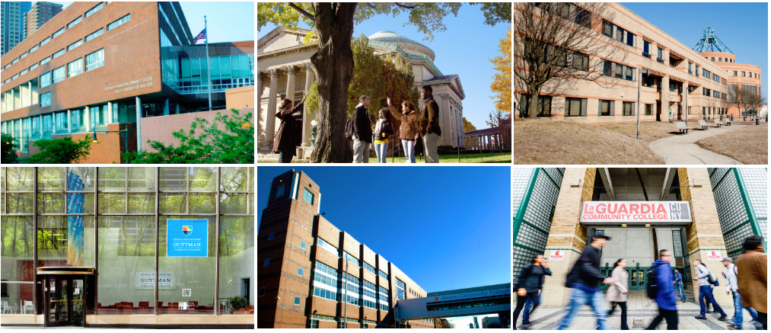‘One thing that is quite clear is that this past year has amplified the need to better serve students at the community college level–students who are the economic engine of New York.’

CUNY
Some of the CUNY schools, clockwise from top left: Borough Of Manhattan Community College, Bronx Community College, Kingsborough Community College, LaGuardia Community College, Hostos Community College and Guttman Community College.The toll of the pandemic has most impacted community college students in the higher education system. With dwindling enrollment for continuing students, lagging recruitment for the next entering class in fall 2021, a dip in student success outcomes, and tightening budgets, faculty are working earnestly to support their students in their courses both online and in-person.
At the Stella and Charles Guttman Community College, part of the City University of New York (CUNY) system, teaching is our highest priority. Our college was built on the idea that as a collective we have to teach differently to ensure that students are able to transition to college and thrive to complete their degree within two years. Our three-year graduation rates exceed the national average. Central to this success is our strong support system and focus on teaching.
Collectively our work is driven by our Instructional Principles which ground the ways we teach: modular classrooms, all classrooms surfaces covered with whiteboards, smartboards, and laptop carts that ensure all students have a computer in almost every classroom, along with year-long professional development on teaching offered through the Center for Practice Technology and Innovation. Our reappointment, promotion, tenure, annual review, and teaching observation processes all focus on teaching.
This past year, as we continued to serve our students amidst a global pandemic, has challenged how faculty teach and do outreach to students. The toll of that work is often invisible. In what seemed like overnight, faculty transitioned their classes to a fully remote environment as New York City grappled with being the epicenter of our nation’s COVID pandemic last spring. They then spent the summer engaging in professional development to prepare for teaching this past year online.
Faculty are the front line workers in our virtual classroom. They are often first to learn of the obstacles students are facing. What we’ve learned in our outreach to students—students missing from classes, non-responsive to online office hours, and missing assignments—is disheartening. Students describe their own hospitalizations, the death of family members, onset of long COVID illnesses in family members, job loss, increased need to work additional part-time jobs to sustain the family structure, homelessness, food insecurity, depression, anxiety and despair from a loss in human contact.
These stories are not merely the stories of one student; often more than a third of students in a course may be facing some sort of trauma or economic instability which has impacted their ability to complete assignments. Faculty have had to pivot to ensure that course and program outcomes are met while finding ways to connect students–many of the most underserved members of the New York community–with institutional support.
The internalization of what has ensued is just now coming to the surface, as we reflect on the past year, pour over comparative data from previous years, provide space for the sharing of teaching strategies and plan for the academic year ahead. Those discussions center on the pain, loss, and trauma of being viscerally close to the stories students tell, coupled with faculty who too have gotten sick and have had to bury loved ones.
The discussions also center on the successes of students, but in an institution focused on teaching, much of the conversation needs to help faculty understand that the impact of COVID goes well beyond what they tried to do, or thought they needed to do, to help students stay on track. With thousands of emails, system flags, and round the clock outreach, often seven days a week, the reality is that even those efforts cannot alleviate the systemic economic and racial disparity that has compounded the impact of COVID on our city’s community college students. And grounded in the faculty’s commitment to equity and social justice, the lag in performance must be studied on a wider scale. And each of us, both students and faculty, must show empathy for ourselves around what we hoped to accomplish when we began this academic year.
Students, faculty, and staff need greater care as we process the trauma of COVID and how it has impacted our work. One thing that is quite clear is that this past year has amplified the need to better serve students at the community college level–students who are the economic engine of New York, and who are often the front line workers who sustained this great city through perhaps the harshest 15 months we’ve endured in decades.
There needs to be greater investment from city, state, and private sector funders to offset student cost of enrollment beyond tuition; we need more full time faculty lines and a greater pipeline for adjunct faculty to earn full time positions throughout the system; and we need support for greater infrastructure and technology to further enhance teaching.
How could the most impacted New Yorker on the front lines of a harsh pandemic be expected to attend college now, with basic and fundamental necessities not met? Let’s be more honest about the toll of the pandemic on those who toil in the shadows to make this great city run.
Nicola Blake, Ph.D. is the dean of faculty and academic affairs and associate rofessor of English at Stella and Charles Guttman Community College.








